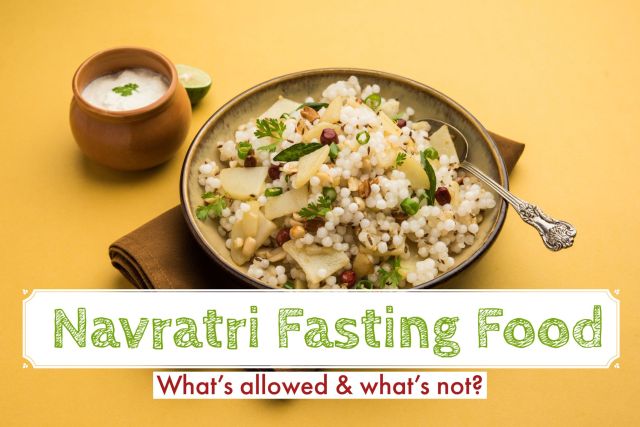The Kala Chana recipe is passed on to generations. The recipe of Kala Chana brings back a lot of childhood memories. It is served with Poori and Sooji Halwa at the end of the Navratri fasting season. This is the traditional Ashtami or Navmi Prasad. The combination of halwa, poori, and chana is lip-smacking and mouth-watering.
It is my version of the Navratri Special Dry Kala Chana Recipe. I make it slightly gravy-style because it tastes better. Enjoy this happy meal every Navratri season. 🙂
Watch YouTube Video
What is the Navratri Festival?
Navratri (also known as Navaratri or Navrate), is a joyous Hindu festival. It is celebrated over 9 to 10 days. “Navratri” is a word from the Sanskrit language – Nav means nine and Ratri means night. This festival is celebrated two times a year, once in the spring (Chaitra Navratri) and once in the autumn (Sharad Navratri). Sharad Navratri falls during September or October and is widely celebrated all across India.
One of the main aspects of Navratri is fasting (known as Vrat or Upvas). During fasting, devotees avoid eating some foods, like grains, pulses, onions, garlic, alcohol, and non-vegetarian items. But they eat fasting food items like fruits, nuts, dairy products, etc.

What food items are allowed in Navratri?
Food items that are allowed during the Navratri season are as follows:
- Vegetables like potato, tomato, arbi, cucumber, carrot, bottle gourd, eggplant, pumpkin, etc.
- Fruits
- Dairy Products
- Coconut
- Nuts and Seeds
- Quinoa, Buckwheat, Little Millet (Samai or Samak), Water Chestnut Flour (Singhade Ka Aata).
- Spices like cumin seeds, red chili powder, turmeric powder, cardamom, carom seeds (ajwain), cinnamon, cloves, black pepper, etc.
- Rock Salt
What food items are not allowed in Navratri?
Food items that are not allowed during the Navratri season are as follows:
- Onion and Garlic: They are Tamsik in nature and hence not consumed.
- Lentils and Pulses like moong dal, chana dal, kidney beans, chickpeas, etc.
- Grains and their flours like wheat flour, gram flour (besan), etc.
- Eggs, Non-Vegetarian Food Items like chicken.
- Alcohol (some people avoid smoking too).
- Salt
- Canned Food Items
Everybody has their own beliefs and follows their own rules during the fasting period. That is why, I suggest you adjust the recipes based on how you follow your fasting and celebrate Navratri.
Tips to make it right
1 – Soaking
Kala Chana takes a long time to cook. It is important to soak them the night before or at least for 6 to 8 hours.
2 – Consistency
Some people make it dry but we prefer a little gravy-like consistency. It tastes better with pooris and halwa. It is not curried but has a little mashed-up consistency. I simply mash it a little from the back of the ladle or spatula once it is done. Don’t overdo it otherwise it will become like a halwa.
Kala chana tends to keep on absorbing water. So, adjust the consistency accordingly. Switch off the flame when it still has some water left. Because once rested for a few minutes, it tends to get dry. You will know when you make it. Don’t worry.

Is this recipe vegan-friendly?
Yes. It is a 100% plant-based recipe.
Generally, this recipe is made using ghee. But since I don’t eat ghee or avoid dairy, I make it using cooking oil. It tastes delicious.
More Vegan Recipes for you to try – Fudgy Chocolate Brownie, Banana Walnut Muffins, Thai Green Curry.
How to cook Kala Chana?
Before cooking Kala Chana or black chickpeas, always soak them in water overnight or at least for 6 to 8 hours. This step is very important because it helps in the faster cooking of chickpeas. After they are soaked for hours, they absorb the water and become bigger. That is why always soak them in a bigger bowl with a water level at least 3 inches above the level of chana.
To cook chickpeas, you will need either a pressure cooker or an Instant Pot.
Pressure Cooker:
Add chickpeas to the pressure cooker with enough water. Add some salt and anardana powder to it. Close the lid and let them cook on high flame till the first whistle. After a whistle, lower the flame and cook for another 20 minutes. Let it depressurize on its own. Once depressurized, you will notice that the chickpeas are soft and tender. They should get mashed on pressing between the fingers.
Instant Pot:
This is the easiest method to cook anything. You just need to add chickpeas, water, some salt, and other seasonings. Close the lid and choose the PRESSURE COOK mode. It cooks in 20 – 25 minutes. Then, let it release the pressure on its own.
I would suggest not to use any pot or pan to cook chickpeas. They take a very long time to get soft and well-cooked.
More Navratri Fasting Recipes
- Roasted Makhana
- Makhana Kheer
- Amaranth and Dates Energy Bars
- Quinoa Cutlets
- Kuttu Ka Cheela (Savory Buckwheat Pancakes)
- Sabudana Khichdi
That’s it, my dear friend. You are all ready to make this kala chana recipe at home. It is one of the best Indian Vegetarian Recipes. It is perfect for an office lunch box too. So, grab all the ingredients because you are ready to make a delicious happy meal for yourself.
If you try this recipe, please share your reviews in the comment section below. Do share a photo on Instagram and tag us @thefearlesscooking. We love seeing your recreation of our recipes.
Happy Cooking.
Love from us
Richa & Jatin













Tell us what you think